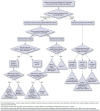Qualitative exploration of factors influencing the plan selection process by Medicare beneficiaries
- PMID: 33645247
- PMCID: PMC10391224
- DOI: 10.18553/jmcp.2021.27.3.339
Qualitative exploration of factors influencing the plan selection process by Medicare beneficiaries
Abstract
BACKGROUND: Because Medicare plan coverage and costs change annually and older adults, the major beneficiaries of Medicare, are faced with multiple health conditions and changing medical needs, Medicare beneficiaries should evaluate their options during open enrollment every year. However, because of the complexity of plan selection, it may be challenging for Medicare beneficiaries to make an appropriate decision from among competing options. OBJECTIVES: To (a) identify factors that beneficiaries consider having influenced their plan selection decision and (b) describe the decision-making process according to the consumer decision-making model (CDM). The 2 research questions guiding this study included (a) factors Medicare beneficiaries considered having influenced their Medicare plan selection decision and (b) characteristics of decision-making processes employed by Medicare beneficiaries. METHODS: This is a phenomenological qualitative study. Semistructured in-person or telephone interviews with Alabama residents who have Medicare as the sole insurance provider were conducted between June and August 2019. Participant recruitment continued until reaching the saturation point. Each interview session consisted of structured questions identifying characteristics of participants and open-ended questions used to elicit participant Medicare plan decisionmaking process and factors affecting their decision. Data were analyzed using content analysis with a process of qualitative inductive coding. RESULTS: Twenty participants were interviewed. Twenty codes were identified and categorized into 5 themes regarding the factors influencing plan selection decisions by beneficiaries. When making a plan selection, participants were influenced by plan attributes (including cost, coverage, access to doctors, region, quality rating, and transportation); information resources and personal assistance; knowledge about Medicare; status and changes in personal situation; and experience with Medicare. Additionally, we identified 7 codes relating to beneficiary characteristics during decision-making processes, including being proactive, setting priorities, limiting choices, evaluating plans against personal needs, acquiescing to recommendations, sticking to the status quo, and weighing trade-offs. We consulted the CDM and created a conceptual model demonstrating a 5-step Medicare plan selection decision-making process and the factors influencing that process. DISCLOSURES: This study was supported by the Auburn University Undergraduate Research Program. The authors declare no conflicts of interest. CONCLUSIONS: This study created a step-by-step decision flowchart of Medicare plan selection to illustrate the complexity of the plan selection that Medicare beneficiaries must use. We uncovered the plan selection decision-making process among Medicare beneficiaries and factors affecting that process. Drawing from the CDM and the study findings, we developed a conceptual model. Findings will help researchers and community agencies target Medicare beneficiaries with different needs for assistance and design decision-making interventions/tools to help beneficiaries make rational decisions when selecting Medicare plans. These findings suggest that health care professionals should be involved in assistance programs to maximize efficiency of Medicare plan selection and to improve monitoring and consulting mechanisms to ensure the reliability of assistance information and services.
Conflict of interest statement
This study was supported by the Auburn University Undergraduate Research Program. The authors declare no conflicts of interest.
Figures
Similar articles
-
The Roles of Cost and Quality Information in Medicare Advantage Plan Enrollment Decisions: an Observational Study.J Gen Intern Med. 2016 Feb;31(2):234-241. doi: 10.1007/s11606-015-3467-3. Epub 2015 Aug 18. J Gen Intern Med. 2016. PMID: 26282952 Free PMC article.
-
Association of Health Insurance Literacy With Enrollment in Traditional Medicare, Medicare Advantage, and Plan Characteristics Within Medicare Advantage.JAMA Netw Open. 2022 Feb 1;5(2):e2146792. doi: 10.1001/jamanetworkopen.2021.46792. JAMA Netw Open. 2022. PMID: 35113164 Free PMC article.
-
Determinants of Medicare plan choices: are beneficiaries more influenced by premiums or benefits?Am J Manag Care. 2015 Jul;21(7):498-504. Am J Manag Care. 2015. PMID: 26247740
-
Risk management frameworks for human health and environmental risks.J Toxicol Environ Health B Crit Rev. 2003 Nov-Dec;6(6):569-720. doi: 10.1080/10937400390208608. J Toxicol Environ Health B Crit Rev. 2003. PMID: 14698953 Review.
-
Drug Treatment Value in a Changing Oncology Landscape: A Literature and Provider Perspective.J Manag Care Spec Pharm. 2019 Feb;25(2):246-259. doi: 10.18553/jmcp.2019.25.2.246. J Manag Care Spec Pharm. 2019. PMID: 30698093 Free PMC article. Review.
Cited by
-
Therapeutic horizons in metabolic dysfunction-associated steatohepatitis.J Clin Invest. 2025 Jul 1;135(13):e186425. doi: 10.1172/JCI186425. eCollection 2025 Jul 1. J Clin Invest. 2025. PMID: 40590228 Free PMC article. Review.
-
Growth Of Chronic Condition Special Needs Plans Among Dual-Eligible Beneficiaries, 2011-24.Health Aff (Millwood). 2025 Mar;44(3):304-312. doi: 10.1377/hlthaff.2024.00651. Health Aff (Millwood). 2025. PMID: 40030115
References
-
- Jacobson G, Freed M, Damico A, Neuman T; Kaiser Family Foundation. Medicare Advantage 2020 spotlight: first look. October 24, 2019. Accessed January 29, 2021. https://www.kff.org/report-section/medicare-advantage-2020-spotlight-fir...
-
- Kaiser Family Foundation. An overview of the Medicare Part D prescription drug benefit. October 14, 2020. Accessed January 29, 2021. https://www.kff.org/medicare/fact-sheet/an-overview-of-the-medicare-part...
-
- Marzilli Ericson KM. Consumer inertia and firm pricing in the Medicare Part D prescription drug insurance exchange. Am Econ J: Econ Policy. 2014;6(1):38-64.
-
- Kaiser Family Foundation. An overview of Medicare. February 13, 2019. Accessed January 29, 2021. https://www.kff.org/medicare/issue-brief/an-overview-of-medicare/
-
- Salive ME. Multimorbidity in older adults. Epidemiol Rev 2013;35:75-83. - PubMed
MeSH terms
LinkOut - more resources
Full Text Sources
Other Literature Sources
Medical
Miscellaneous



